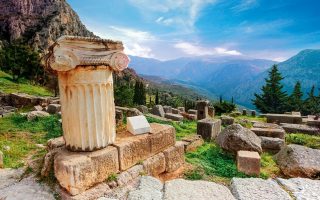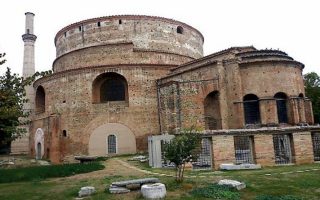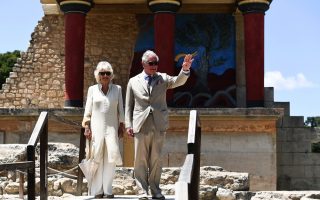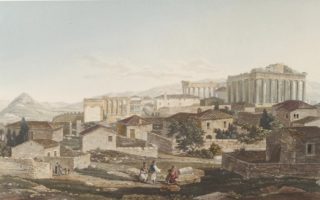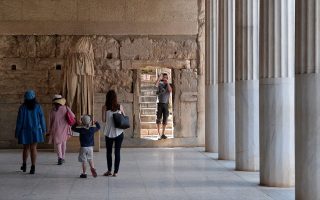Asclepius Sanctuary discovery adds new details to timeline
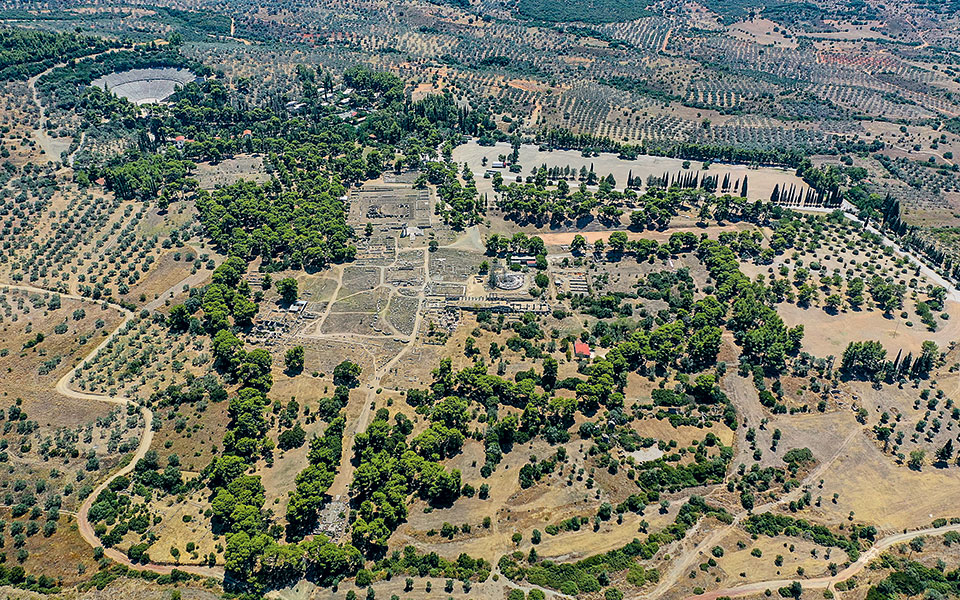
Visitors to the Ancient Theater of Epidaurus in the eastern Peloponnese are increasingly fascinated by the treasures being unearthed in excavations of the assembly of monuments comprising the Sanctuary of Asclepius, hailed as the greatest center of healing in the ancient world. Interest has focused on the site again following the recent discovery of a structure right beside the Tholos, a circular building from 365-335 BC believed to have been the most important in the sanctuary.
The Archaic building, found at a depth of 3 meters, is important in that it provides evidence that the Tholos was the chthonic residence of Asclepius from when he first arrived in Epidaurus. This, moreover, did not happen in the mid-6th century BC as was believed until now, but after the end of the 7th. The building is also invaluable in what it tells us about the evolution of architecture and how Asclepius was worshipped at the time.
Excavation director and Professor Emeritus of Classical Archaeology Vassilis Lambrinoudakis describes the discovery of the building as an “enchanting piece of research.”
The building’s discovery started in 2015 with aerial photographs of the sanctuary. “We saw that an altar, which we attributed to Apollo and is Archaic and around 50 meters east of the Tholos, was located in a straight line from the round structure and facing it. We later studied the area and found an inscription with which the altar was later sealed. It belonged to Epioni, Asclepius’ wife. However, it is from the 6th century BC and the Tholos is from the 4th. Here’s what made us pay attention: Since the altar faced the Tholos and is in a straight line from it, there must be something older there as well.”
One part of the Archaic building is beneath the Tholos and another, older one, beneath the altar (550 BC). “But the building is dated to around 600 BC and has a slightly different orientation,” adds the professor.
The archaeologists also discovered traces of a large pyre in front of the Tholos, at least 6 meters wide, which ran beneath the Tholos. As they dug down to follow the line of the pyre’s trench, they came to a mosaic of very good quality at a depth of 5 meters, part of a room that they now know was a basement.
Excavations in 2018 and 2019 turned up foundation stones around the trench, which was filled with construction material, and bricks made of clay and goat’s hair. “The evidence pointed to a brick structure,” says Lambrinoudakis, adding that pieces of worked limestone were also discovered.
“It was a well-built basement topped with a wood and brick structure with a peristyle with wooden columns. It was a two-story building like the Tholos,” he explains.
This year’s excavations by the University of Athens (with the support of the Argolida Ephorate of Antiquities and the Stavros Niarchos Foundation) revealed the full breadth (3.6 meters of the basement and 4.6 m of the top floor) of the building and a large part of its length (10.2 m). The rest, the part stretching beneath the Tholos to the south, is expected to be uncovered next year. They also found traces of a staircase leading up from the basement.
“It is a very important building, a precursor to the Tholos, which was Asclepius’ tomb. It was the underground residence of Asclepius, who had divine status. He was a hero and a god, both chthonic and celestial. He had the ability to die but also to be eternal. He embodied the power of nature to die and to be reborn the following year from its seed. Asclepius healed through the powers of the earth, because sleep was a magical imitation of death. In Epidaurus, they believed Hypnos to be the brother of Thanatos,” says Lambrinoudakis.
Healing by enkoimesis
Patients were healed by a process called enkoimesis, a state of induced sleep, at the Enkoimeterion or Abaton. “The building is one story at its east wing and two at its west. Supplicants would descend to the dark basement to sleep on the earth or on the skin of an animal they had sacrificed,” says the archaeologist.
Asclepius would visit them in a dream, either to heal them outright or recommend a medicine or course of treatment. The archaeologists were surprised to discover that the roof of the Tholos’ basement was at exactly the same level as the roof of the Abaton, indicating a deliberate piece of architecture. “The patient would descend to the Abaton’s basement to reach the ground, where he would meet Asclepius, who was right next door, in the basement of the Tholos,” explains Lambrinoudakis.
The Archaic building was demolished to make way for the Tholos, but in order to honor it duly it was first filled with fragments from other sacred sites in the area that came down.
As Asclepius was both mortal and immortal, he needed an altar for both his chthonic and celestial personification. Chthonic altars consisted of a hole in the ground through which offerings such as fruit juice, milk and honey were poured, while the other altar was used for the animal sacrifices.
“We have indications and remains from Archaic sacred structures that must have been some kind of temple to celestial Asclepius. Some 20 meters east of the Tholos, however, we have Building E, which is the first altar used for animal sacrifices. Post-excavation research there yielded shells from the 7th century, which means that when the cult from the Sanctuary of Apollo Maleatas descended [from higher ground] in the 7th century BC, chthonic and celestial Asclepius was already around,” says Lambrinoudakis.
Archaeological park
The next few months should also see the launch of a 985,000-euro project for transforming the site into an archaeological and nature park. This will entail fencing off the entire site – as many of its buildings are outside the perimeter today – building a proper entrance and parking area, and creating a footpath around the ruins, with signs and digital media informing visitors about the different buildings and locations. Visitors will learn about the Stoa of Kotyos, where pilgrims would put their votive offering before entering the sanctuary, the library, where patient information was kept, and about the springs and the baths.
There are also developments on the restoration front. “We will soon be able to see two Corinthian columns standing at their full height at the emblematic Tholos building. Restoration has finished at the Abaton and also at the banquet hall, while we hope that a column at the Temple of Asclepius will also be restored soon so that this important building will also become more three-dimensional,” explains Lambrinoudakis.

